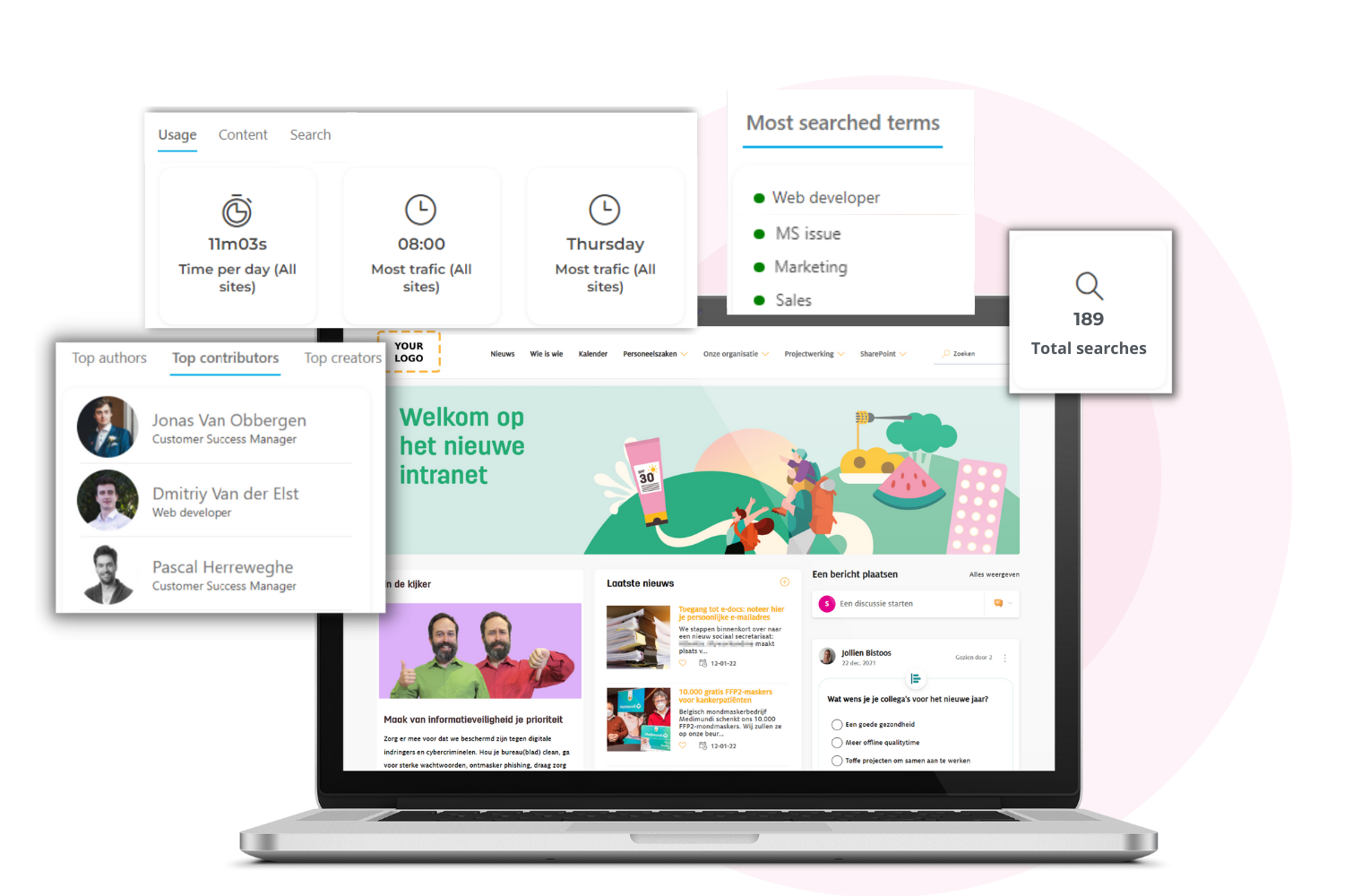Measuring the impact of your internal communication (IC) strategies is crucial for understanding their effectiveness and driving continuous improvement.
Are you struggling to gauge the success of your IC efforts? This blog post shares three proven ways to measure the effectiveness of your internal communications.
But first, let’s explore why measuring IC is important for businesses.
Why measure IC?
You can’t improve what you don’t measure. Successful IC requires continuous measurement and data-driven optimization.
Understanding the significance of measuring IC will help you stay focused, motivated, and set tangible goals.
Several compelling reasons highlight the importance of measuring IC:
- To improve internal communication and collaboration
- To streamline processes for higher productivity
- To enhance workplace culture through employee engagement
- To justify your internal communications budgets
- To demonstrate your efforts and value
Among these reasons, justifying your budget and proving your value stand out as particularly important. At the end of the day, you need to show the senior leaders holding the purse strings that your work is making a real difference. Whether you’re looking to invest in new communication tech or initiatives, or just making the case for your current resources, you’ll need hard data to back you up.
While the pandemic brought more attention to internal communications, it’s still an undervalued role in many organizations. The reality is, communication professionals like yourself play a vital role – strategizing overall approaches while being meticulous with messaging details. So it’s time to step into the spotlight and get the hero recognition you deserve.
PRO TIP: How to Define Your “Why”?
If you’re still struggling to define your “why,” look at your organizational goals and core values, and align your internal communication goals with these.
Engaging teams around purpose, strategy, and values has been
the top priority for IC teams in 2024.
(Source: State of the IC sector 2023/2024)
The impact of IC
Effective internal communication has a direct and profound impact on business success. The benefits are clear and well-documented:
- 72% of business leaders believe that effective communication has increased their team’s productivity (Source)
- 52% of knowledge workers agree that effective communication enhances productivity (Source)
- Companies with a strong positive culture generate 4 times more revenue growth than those with a weak culture (Source)
- Organizations with engaged employees have 98% higher customer satisfaction and 50% higher customer loyalty than those with disengaged employees (Source)
Effective internal communication fosters a collaborative, productive, and engaged workforce, which translates into tangible business outcomes such as increased revenue, customer satisfaction, and loyalty. A culture of open and transparent communication empowers employees, aligns them with organizational goals, and drives collective success.
When internal communication strategies are well-executed, they break down silos, facilitate knowledge sharing, and enable seamless cross-functional collaboration, ultimately enhancing operational efficiency and productivity across the organization.
3 effective ways to gauge the success of your IC
Despite these compelling statistics, even top communication teams often struggle to demonstrate their value without robust quantitative and qualitative measurement. According to the State of IC Sector 2023/24, lack of analytics remains one of the top 5 barriers to success for internal communications teams in 2024, with larger organizations facing greater challenges in this area.

These are three reliable method for effectively evaluating your internal communications.
1. Use Analytics
Gathering the right data through analytics is crucial for measuring the success of your internal communication efforts. While analytics aren’t the only way to measure success, they provide data-backed insights to optimize your strategies.
To effectively measure the success of your internal communication efforts, it’s crucial to set relevant Key Performance Indicators (KPIs). These KPIs should encompass various metrics from all internal communication channels and platforms you are using, such as tracking open rates and click rates in emails, counting page views on your intranet, measuring social media interactions, and determining video view counts.
Don’t forget to keep track of your KPIs regularly. Evaluate performance on a weekly, monthly, quarterly, and annual basis. By staying up-to-date, you’ll know exactly where you can optimize your internal communication strategies
When it comes to comprehensively tracking these KPIs, modern intranets like Involv make the process seamless. If you’re using Involv for your intranet, you can leverage our advanced analytics center – a unified hub providing important KPIs at a glance, including:
- Usage metrics: number of users, peak traffic times/days, time spent, etc.
- Site and content metrics like page visits, top performing contents, top channels
- Search analytics to optimize findability.
- Profile analytics to identify intranet influencers.
- Heatmaps revealing user navigation patterns.
- Mobile usage is broken down by department
- Reports on notifications, mandatory reads, comments, and more

2. Conduct Pulse Surveys
Analytics alone don’t give the full picture. Pulse surveys let you hear directly from employees about what’s working and what’s not, what needs to be improved and what needs to be stopped.
Launch a survey or open a forum on your intranet where employees can provide feedback. It is an excellent way to find out where the problems lie in your communication strategy and to get ideas to fine-tune your strategy.
Keep survey questions simple and direct, like:
- Do you feel connected to the company’s vision and purpose?
- Do you understand our goals and how your work contributes?
- Do you, as a remote worker, feel included and informed in the company?
- Are you a fan of reading internal communications?
- Can you easily access important information?
- Is communication strong across teams and departments?
Make sure you have an easy tool to create and manage surveys so it doesn’t become overly burdensome.
With Involv intranet, for example, you can build polls right into pages using the drag-and-drop template builder. This makes launching quick org-wide surveys super easy to capture and share data. Involv also integrates perfectly with Microsoft Forms for more robust surveying needs.
One important note: It is essential to keep in mind that having too many or excessively lengthy surveys may lead to employee annoyance and distraction. For high response rates, keep surveys concise (1-10 questions) and make them anonymous when appropriate. Always share back results and next steps too.
Combine this qualitative employee feedback with your analytics data. You’ll gain a clear view of what resonates and where to focus improvements.

3. Monitor Social Activities
It’s not enough to just measure how many employees receive your internal communications. You also need to gauge how engaged and interested they truly are in the content itself. Low engagement could be a red flag, potentially signaling that employees feel disconnected or out of the loop.
Monitoring activity on social channels, forums, and looking at what content sparks responses provides valuable insight into how well your communications are resonating and driving participation.
Metrics like view counts, likes, comments, and shares can give you meaningful insights into engagement levels.
If you’re using an intranet like Involv, the analytics center provides KPIs on top performing content, including posts with the most likes, comments, and views.
You can also identify your most active and engaged colleagues through user analytics, spotlighting people who create the most articles, give the most feedback, and receive the highest engagement.
Studying these social behaviors and trends within your intranet gives you measurable data to analyze. This allows you to tailor your communication strategies more effectively, aligning them with your business objectives and the types of content that truly resonate with your employees.
For added context, you can complement these social analytics with pulse surveys to understand why certain content succeeds or struggles, and what specific content employees are craving.
Conclusion
Regardless of where your organization is now, tracking and analyzing the performance of your internal communications can provide valuable insights.
By implementing these three proven methods – analytics, pulse surveys, and monitoring social activity – you’ll be well-equipped to measure the effectiveness of your internal communication strategies, optimize your efforts, and demonstrate their impact on the bottom line.
Discover the potential of Involv for intranet solutions. Our team of communication and intranet experts can assist in developing an efficient internal communications platform to address current business obstacles.

